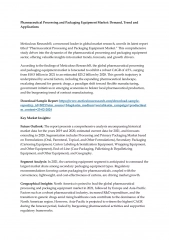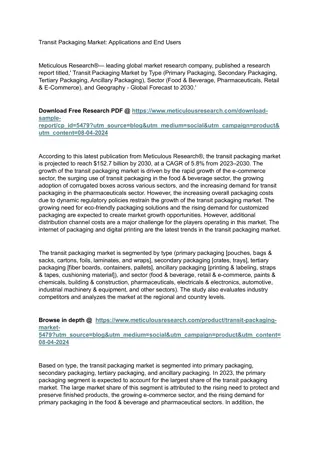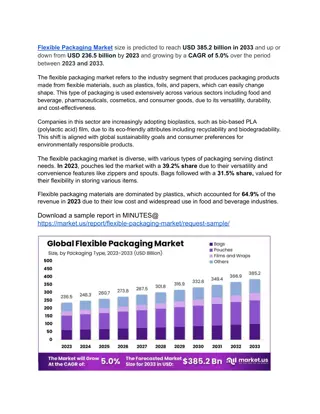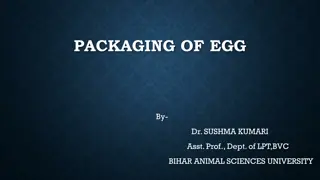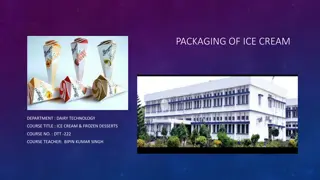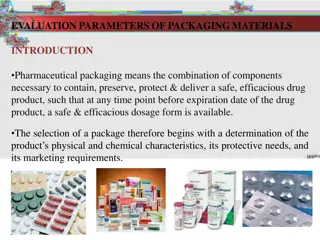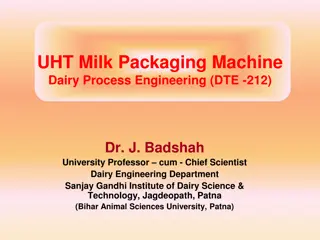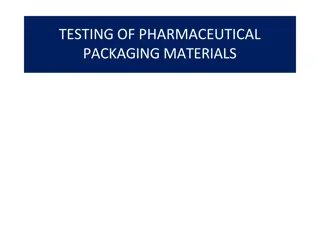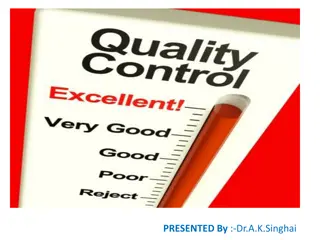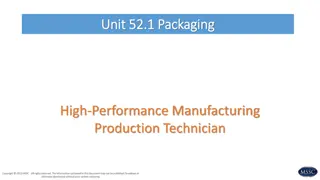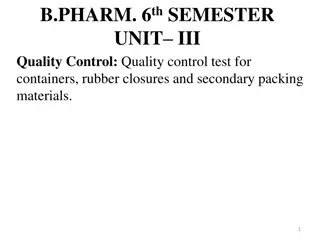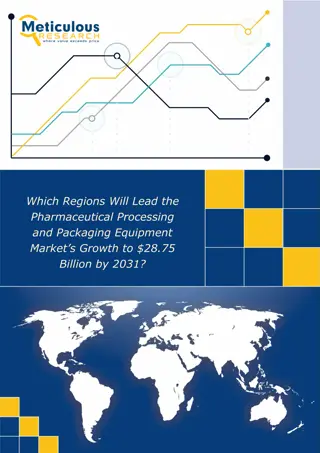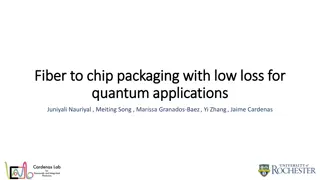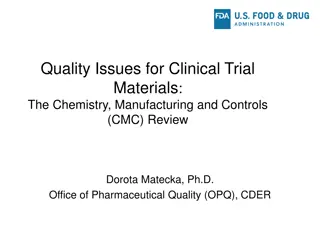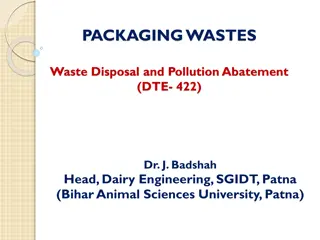Evaluation Parameters of Pharmaceutical Packaging Materials
Pharmaceutical packaging plays a crucial role in ensuring the safety and efficacy of drug products. The selection of packaging materials involves considerations such as protection from environmental conditions, non-reactivity with the product, non-toxicity, FDA approval, tamper resistance, and adaptability to packaging equipment. Different types of containers are used, including glass, plastic, metal, and paper, each serving specific purposes. Packaging evaluation is essential to investigate interactions between products and packages for maintaining product quality. Glass, a commonly used material for parenteral products, requires special care due to its composition and types.
Download Presentation

Please find below an Image/Link to download the presentation.
The content on the website is provided AS IS for your information and personal use only. It may not be sold, licensed, or shared on other websites without obtaining consent from the author. Download presentation by click this link. If you encounter any issues during the download, it is possible that the publisher has removed the file from their server.
E N D
Presentation Transcript
EVALUATION PARAMETERS OF PACKAGINGMATERIALS INTRODUCTION Pharmaceutical packaging means the combination of components necessary to contain, preserve, protect & deliver a safe, efficacious drug product, such that at any time point before expiration date of the drug product, a safe & efficacious dosage form is available. The selection of a package therefore begins with a determination of the product s physical and chemical characteristics, its protective needs, and its marketing requirements.
The materials selected must have following characteristics They must protect the preparation from environmental conditions. They must not be reactive with the product. They must not impart to the product tastes or odors. Must be non toxic. They must be FDA approved. They must meet applicable tamper resistance requirements. They must be adaptable to commonly employed high-speed packaging equipment
Packaging materials and closures Containers A pharmaceutical container is defined as a device that holds the drugs an is or may be in direct contact with the preparation. Types of containers Materials used for making containers Glass Plastic Metal Paper and board Well-closed containers Single dose containers Multi dose containers Light-resistant containers Air-tight containers Aerosol containers
TYPES OFPACKAGING 1.Primary packaging 2.Secondary packaging 3.Tertiary packaging It is the material that first envelops the product and hold it. This usually is the smallest unit of distribution or use. It is outside the primary packaging perhaps used to group primary package together. It is used to bulk handling and shipping. Ex. Aerosol spraycan, blister packs, bottle. Ex. Boxes, cartons. Ex. Barrel, container, edge protector.
Packaging Evaluation Package evaluation is performed to investigate the physicochemical interactions that might occur between the product & package. The ideal package would be completely inert relative to the product & would provide maximum shelf-life. Therefore, evaluation is designed to identify, characterize & monitor these interactions to achieve a safe, unadulterated, stable & efficacious product. A number of tests can be used to establish initial qualification of the container closure system, and a quality control plan can help ensure compatibility and safety
A. GLASS Glass is one of the most widely used material for parenteral product so special care has to be taken in case of the glass. Composition of Glass Types of Glass Type 1:-Neutral or Borosilicate glass. Type 2:-Treated Soda-lime glass. Type 3:-Regular Soda-lime glass. Type 4:-General Purpose Soda-lime glass. Glass is composed of sand, soda ash, lime stone and cull.et Evaluation of Glass Containers 1. Chemical resistance of glass containers A) Powdered glass test B) Water attack test
Testes Containers Type 1 Type 3 Type NP Type 2 (100 ml or less) Type 2 (over 100 ml ml of 0.02 N H2SO4 1 8.5 15 0.7 0.2 1.Powder glass test 2.Water attack test 2.Hydrolytic resistance of glass container Nominalcapacity of container (ml) Volume of test solution to be used for titration (ml) Number of containers to be used 5 or less at least 10 50.0 6 to 30 at least 5 50.0 More than 30 at least 3 100.0
3.ARSENICTEST Washed the inner and outer surface of container with fresh distilled water for 5min. Prep test as described in the test for hydrolytic resistance for an adequate no. of samples to produce 50ml. pipette out 10ml solution from combined contents of all ampoules to the flask. Add 10ml of HNO3 to dryness on the water bath, dry the residue in an oven at 130 C for 30min cool and add 10ml hydrogen molybdate reagent .Swirl to dissolve and heat under water bath and reflux for 25min. Cool to room temp and determine the absorbance at 840nm.Do the blank with 10ml hydrogen molybdate. The absorbance of the test solution should not exceed the absorbance obtained by repeating the determination using 0.1ml of arsenic standard solution (10ppm) in place of test solution
B. PLASTIC Plastics are synthetic polymers of high molecular weight. Plastic is made from one or more polymers together with certain additives. The polymers commonly used are polyethylene, polypropylene, polyvinyl etc. Classification of Plastics 1.Thermoplastic type 2.Thermosetting type Evaluation of Plastic 1.LeakageTest Fill 10 containers with water, fit with intended closures and keep them inverted at room temperature for 24hr.The test is said to be passed if there is no signs of leakage from any container.
2. CollapsibilityTest This test is applicable to the containers which are to be squeezed for removing the contents. A container by collapsing inward during use, yield at least 90% of its normal contents at the required rate of flow at ambient temperature. 3.Water Vapour PermeabilityTest Fill 5 containers with normal volume of water and heat seal the bottles with an aluminium foil. Weigh accurately each container and allowed to stand for 14days at a relative humidity of 60 5% and a temperature between 20 and 25 C.Reweigh the containers. The loss in weight in each container is NMT 0.2% .
C. CLOSURES Closures are the devices by means of which containers can be opened and closed. A closure is the part of the package which prevent the contentsfrom escaping and allow no substance to enter the container. It prevents deterioration of the product from the effect of the environment such as moisture, oxygen or carbon dioxide . Types of Closures Materials used for making of Closures 1. Threaded screw cap 2. Lug cap 3. Crown cap 4. Roll on closures 5. Pilfer proof closures. 1. 2. 3. 4. 5. Cork Glass Plastic Metal Rubber
Evaluation of closures 1.FRAGMENTATION TEST(IP1996) place a volume of water corresponding to nominal volume-4ml in each of 12 clean vials, close vial with closure and secure caps for 16hrs. pierce the closure with number 21 hypodermic needle(bevel angle of 10 to 140c)and inject 1ml water and remove 1ml air repeat the above operation 4 times for each closure count the number of fragments visible to naked eye Total number of fragments should not be more than 10. 2.SELF SEALABILITY TEST FOR RUBBERCLOSURES fill 10 vials with water to small volume and close the vials with closures, pierce the cap and closures 10 times at different places with no 21 syringe needle. immerse the vials in 0.1 %W/v solution of methylene blue under reduced pressure, restore the nominal pressure and keep the container for 30 min and wash the vials. None of the vial should contain traces of colored solution.



